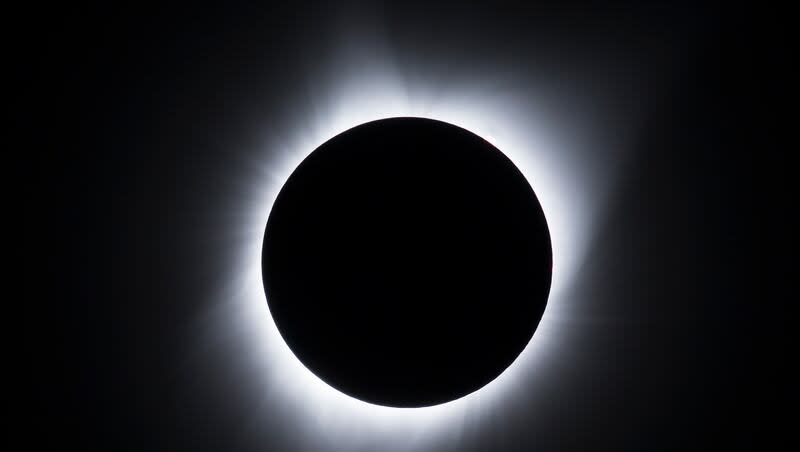The predictable miracle of the solar eclipse

A remarkable image circulated on social media this week. It showed a narrow strip of America where Airbnbs were fully booked on Sunday. Call it the Miracle Belt — the places where, for a few minutes on Monday, weather permitting, the solar eclipse will be seen in eerie and glorious totality.
It is a miracle, albeit one explained by science.
This is incredible.
From @Jamie_Lane where AirBnBs are fully booked next week. pic.twitter.com/ITKZJaGfY8— Mike Simonsen 🐉 (@mikesimonsen) April 4, 2024
But that’s not a miracle, literalists might say.
Well, no, not in the most literal sense of the word, not the way that C.S. Lewis described the miraculous: “an interference with Nature by supernatural power.” But there are everyday miracles, too, by which I mean events so extraordinary that they ought to be heralded by trumpets, even though they are part of “ordinary” life. Your conception and birth were two such events, as is the migration of humpback whales and salmon, and the emergence of every single butterfly this spring. It’s hard to imagine now, but as recently as 1983, a PBS special on embryonic development was called “The Miracle of Life.”
Everyday miracles are conduits of awe when we pay attention, and too often we don’t. But it’s hard to ignore a total solar eclipse.
We have come a long way in our understanding of celestial events. Even the Star of Bethlehem has been explained in coldly scientific terms, and some say the darkness that fell over Golgotha when Christ was crucified was a lunar eclipse. In ancient times, when the sun disappeared behind the moon for a few minutes, our ancestors saw calamity in the unexpectedly dark sky. A solar eclipse was, for a few despairing hours, reason to believe that the sun was forever gone, and with it, all light and sustenance.
No one believes that today, even though as 15 states prepared for an influx of eclipse tourists, there were still some peddling predictions of doom. Among the wildest theories of impending apocalypse were those that pointed out that the paths of the 2017 and 2024 solar eclipses form a giant “X” over America and thus should be considered proof that America has been marked by God (or Elon Musk) in some sinister way.
But you don’t have to descend into the rabbit hole of conspiracy theories involving the number of towns named Nineveh in the eclipse path to see the eclipse for what it really is: a predictable miracle. Just because we know what is transpiring in the sky doesn’t make it any less miraculous. In fact, it seems all the more miraculous, when you think about the fact that not only do we understand what is happening when the moon seems to eat the sun, but that some of our fellow human beings were able to predict the timing centuries in advance, with 3-pound brains in bodies that evolved from a single-cell organism, according to science. That’s miracle enough for me.
But there’s more.
There is also the miracle of these massive orbs, whose size we can scarcely comprehend, following their orderly, precise path in the cold and quiet of space. Like clockwork, we might say, only our clocks don’t always work that well. When life on Earth swirls with disorder and chaos, the spinning of the planets on their predictable paths can bring solace, whispering that Someone is in charge.
So, too, can the stunning images from the Hubble and James Webb telescopes, which make God seem bigger and more unimaginably powerful with every photo beamed back to Earth. But of course, we don’t have to look skyward to see the grandeur of God. There is just as much order and precision and beauty in things that are so tiny that we can’t see them — from the impossible geometric beauty of a single snowflake to grains of sand seen under a microscope. Everyday miracles surround us; we just rarely pause to see them, to let the awe in.
microscopic image of dew on a spider web pic.twitter.com/nIddhFCzF0
— microscopic images. (@microscopicture) March 23, 2024
After the 2017 solar eclipse, a team of researchers studied social media posts from people who had seen the eclipse and those who hadn’t. They concluded that viewing the eclipse could be literally life-changing. In addition to describing the event with words like “sublime” and “transcendental,” people who had witnessed totality described an all-encompassing sense of awe, a peak experience that can grow ever distant for those who keep the mysteries of God and religious faith at arm’s length.
Knowing that, the question isn’t why so many are going to great lengths to see the eclipse, but why so many people aren’t. I live within a few hundred miles of totality and have asked people for weeks if they were traveling on Monday, and most said no. This shouldn’t surprise me. Many times, I have watched explosive sunsets over the ocean in sight of homes where people sat in front of their TVs. No matter how spectacular a show God puts on, somewhere there’s a “meh.” That’s why a total solar eclipse, which won’t occur in the U.S. for another 20 years, seems so much like God trying to get our attention, trying to get us to put down our phones, to see what real beauty and and real power look like.
I’ve heard about a restaurant on Martha’s Vineyard where it’s traditional for patrons to applaud the setting sun each night, which seems entirely appropriate. There might not be applause during totality on Monday — awe tends to invite quiet. But there will be no “mehs” when the sun and moon embrace, and it’s worth stopping whatever you’re doing to watch.
NASA will broadcast a livestream of the 2024 solar eclipse here.

